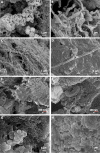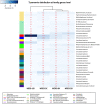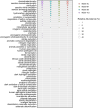Prokaryotic communities from a lava tube cave in La Palma Island (Spain) are involved in the biogeochemical cycle of major elements
- PMID: 34026356
- PMCID: PMC8121065
- DOI: 10.7717/peerj.11386
Prokaryotic communities from a lava tube cave in La Palma Island (Spain) are involved in the biogeochemical cycle of major elements
Abstract
Lava caves differ from karstic caves in their genesis and mineral composition. Subsurface microbiology of lava tube caves in Canary Islands, a volcanic archipelago in the Atlantic Ocean, is largely unknown. We have focused the investigation in a representative lava tube cave, Fuente de la Canaria Cave, in La Palma Island, Spain, which presents different types of speleothems and colored microbial mats. Four samples collected in this cave were studied using DNA next-generation sequencing and field emission scanning electron microscopy for bacterial identification, functional profiling, and morphological characterization. The data showed an almost exclusive dominance of Bacteria over Archaea. The distribution in phyla revealed a majority abundance of Proteobacteria (37-89%), followed by Actinobacteria, Acidobacteria and Candidatus Rokubacteria. These four phyla comprised a total relative abundance of 72-96%. The main ecological functions in the microbial communities were chemoheterotrophy, methanotrophy, sulfur and nitrogen metabolisms, and CO2 fixation; although other ecological functions were outlined. Genome annotations of the especially representative taxon Ga0077536 (about 71% of abundance in moonmilk) predicted the presence of genes involved in CO2 fixation, formaldehyde consumption, sulfur and nitrogen metabolisms, and microbially-induced carbonate precipitation. The detection of several putative lineages associated with C, N, S, Fe and Mn indicates that Fuente de la Canaria Cave basalts are colonized by metabolically diverse prokaryotic communities involved in the biogeochemical cycling of major elements.
Keywords: Biogeochemical cycles; La Palma Island; Lava tube; Proteobacteria; Volcanic cave.
©2021 Gonzalez-Pimentel et al.
Conflict of interest statement
Octavio Fernandez-Lorenzo is the president of Grupo de Espeleologia Tebexcorade, a non-profit sports club of speleologists.
Figures







References
-
- Beier C, Haase KM, Brandl PA. Melting and mantle sources in the Azores. In: Kueppers U, Beier C, editors. Volcanoes of the azores: revealing the geological secrets of the central Northern Atlantic Islands. Springer; Heidelberg: 2018. pp. 251–280.
-
- Bradshaw DJ. D. Phil. Thesis. 2020. Effects of natural and anthropogenic impacts on the microbiome of the Indian River Lagoon, Fl, USA.
LinkOut - more resources
Full Text Sources
Other Literature Sources
Miscellaneous

